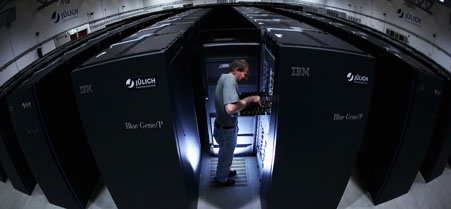Nuclear security agency earns kudos for green supercomputers
NNSA's machines rank not only among the world's fastest but also the most energy efficient.
 The Blue Gene series of computers was developed by IBM with investments from NNSA.
The Blue Gene series of computers was developed by IBM with investments from NNSA.
For the second time in two weeks, the agency that maintains and enhances the safety, security, reliability and performance of the U.S. nuclear weapons stockpile received accolades for supercomputing technology that leads the industry both in energy efficiency as well as processing power.
Energy efficiency and supercomputers might seem like an oxymoron, given that the latter are synonymous with massive mainframes that provide the kind of processing speeds necessary to perform extremely complex mathematical calculations. But the sixth edition of the Green500 List , released on Friday, recognized supercomputers with the highest flops per watt, or computations delivered by a computer for every watt of power consumed. Eight of the supercomputers that made the list are housed at the National Nuclear Security Administration, which was established by Congress in 2000 as a semiautonomous agency within the Energy Department responsible for enhancing national security through the application of nuclear science.
NNSA's supercomputers, which simulate testing of nuclear weapons to determine whether they're secure and functional, also made the related TOP500 List , which ranks the world's fastest supercomputers.
"We started off in the early days building big machines, but then the light bulb came on that we can't afford the power consumption or the floor space," said Bob Meisner, acting director of NNSA's Advanced Simulation and Computing Office. "At that point, we decided we ought to look at better solutions."
Meisner estimated that the processing cost for supercomputing is roughly $1 million per megawatt. To put that in perspective, NNSA's Blue Gene/P Solution computer at the Lawrence Livermore National Laboratory consumes 1.13 megawatts of power annually. President Obama presented the National Medal of Technology and Innovation to the Blue Gene series of computers, which IBM developed with investments from NNSA and the Energy Department.
"Blue Gene was a technology that was languishing," Meisner said. "But we saw it as viable for our future, and took up the mantle by partnering with IBM" and the Energy Department's Office of Science to continue development. The supercomputer is powered by a more energy-efficient processor than those used in IBM's other mainframe computers, and with each subsequent generation its memory and processing capability have improved as well. Meisner expects the next generation -- the Blue Gene/Q Solution -- to be delivered by 2012.
"None of these machines at this scale would ever be built without government investment, primarily because other industries just want to buy the most capable thing they can get to do their job," he said. "If the government doesn't make the investment, this particular technology doesn't progress."
Long term, NNSA plans to move to exascale computing, which can handle a million trillion calculations per second.
"I don't think practically anyone would build anything that wasn't constrained by power somehow," Meisner said. "If we were to go to exascale, we'd be building a machine that [consumes] 100 megawatts of power in a single year, which would cost $100 million dollars to operate. No one will build machines like that. We had to find a way to be more power efficient, whether you call it green technology or just a way of doing business."
NEXT STORY: VA Watchdog Hacked


